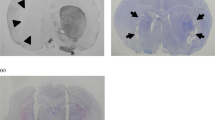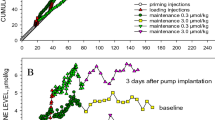Abstract
OF all the side effects of drugs used to treat psychotic illness such as schizophrenia, chronic tardive dyskinesias are the most disturbing. They appear after months or years of therapy, and persist when the offending drug is withdrawn in about half of the cases. Such tardive dyskinesias resemble in character abnormal movements produced by levodopa in patients with Parkinson's disease. They can be controlled by drugs that antagonise the cerebral actions of dopamine (DA)1. Thus, they seem to be due to overstimulation of cerebral DA receptors, although they are caused by neuroleptic drugs which, in acute experiments, antagonise cerebral dopamine receptor action2–5. This paradox has been resolved by suggesting that such drugs, by binding to and antagonising cerebral DA receptors, may eventually actually increase receptor sensitivity. Indeed, following treatment for a few weeks with phenothiazines or butyrophenones and withdrawal of the drugs, animals exhibit behavioural and biochemical supersensitivity to DA agonists which persists for some time6–13. However, tardive dyskinesias usually appear while the patient continues to take the offending drug, so we have studied the effect on striatal DA receptor activity of continuous 6-month administration to rats of a potent neuroleptic drug in common clinical use (trifluoperazine). At intervals the animals were tested for a behavioural response to the DA agonist apomorphine, and were killed for biochemical assessment of DA turnover and DA receptor activity in that part of the brain (the corpus striatum) believed to be the site responsible for production of tardive dyskinesias. We report here that the initial behavioural and biochemical evidence for striatal DA receptor blockade by trifluoperazine disappears within a few weeks of starting therapy, to be replaced by supersensitivity after 6 months of drug administration, despite continued drug intake.
This is a preview of subscription content, access via your institution
Access options
Subscribe to this journal
Receive 51 print issues and online access
$199.00 per year
only $3.90 per issue
Buy this article
- Purchase on Springer Link
- Instant access to full article PDF
Prices may be subject to local taxes which are calculated during checkout
Similar content being viewed by others
References
Marsden, C. D., Tarsy, D. & Baldessarini, R. J. in Psychiatric aspects of Neurologic Disease (eds Benson, D. F. & Blumer, D.) 219–265 (Grune and Stratton, New York, 1975).
Carlsson, A. & Linqvist, M. Acta pharmac. tox. 20, 140–144 (1963).
Van Rossum, J. M. Archs int. Pharmacodyn. Ther. 160, 492–494 (1966).
Randrup, A. & Munkvard, I. in Amphetamines and Related Compounds (eds Costa, E. & Garattini, S.) 695–713 (Raven, New York, 1970).
Carlsson, A. Psychol. Med. 7, 583–597 (1977).
Klawans, H. L. & Rubovitz, R. J. neural Transmission 33, 235–246 (1972).
Fjalland, B. & Moller Nielsen, I. Psychopharmacologia 34, 105–109 (1974).
Tarsy, D. & Baldessarini, R. J. Neuropharmacology 13, 927–940 (1974).
Moore, K. E. & Thornbury, J. E. in Adv. Neurol. 9, 93–104 (1975).
von Voigtlander, P. F., Lorenz, E. G. & Trienzenberg, H. J. J. Pharmac. exp. Ther. 193, 88–94 (1975).
Sayers, A. C., Burki, H. R., Ruch, W. & Asper, H. Psychopharmacologia 41, 97–104 (1975).
Muller, P. & Seeman, P. Life sci. 27, 1751–1759 (1977).
Burt, D. R., Creese, I. & Snyder, S. H. Science 196, 326–328 (1977).
Westerink, B. H. C. & Korf, J. J. Neurochem. 29, 697–706 (1977).
Miller, R. J., Horn, A. S. & Iversen, L. L. Molec. Pharmac. 10, 759–765 (1974).
Creese, I., Burt, D. R. & Snyder, S. Life sci. 17, 1715–1720 (1975).
Leysen, J. E., Niemegeers, C. J. E., Tollanaere, J. P. & Laduron, P. M. Nature 272, 168–171 (1978).
Asper, H. et al. Eur. J. Pharmac. 22, 287–294 (1973).
Moller Nielsen, I., Fjalland, B., Pedersen, V. & Nymark, M. Psychopharmacologia 34, 95–104 (1974).
Author information
Authors and Affiliations
Rights and permissions
About this article
Cite this article
CLOW, A., JENNER, P., THEODOROU, A. et al. Striatal dopamine receptors become supersensitive while rats are given trifluoperazine for six months. Nature 278, 59–61 (1979). https://doi.org/10.1038/278059a0
Received:
Accepted:
Published:
Issue Date:
DOI: https://doi.org/10.1038/278059a0
This article is cited by
-
Do neuroleptic drugs still have a place in neurological therapy?
Journal of Neurology (1990)
-
Striatal binding of11C-NMSP studied with positron emission tomography in patients with persistent tardive dyskinesia: no evidence for altered dopamine D2 receptor binding
Journal of Neural Transmission (1990)
-
Effects of discontinuous drug administration on the development of dopamine receptor supersensitivity during chronic trifluoperazine or cis-flupenthixol administration to rats
Psychopharmacology (1985)
Comments
By submitting a comment you agree to abide by our Terms and Community Guidelines. If you find something abusive or that does not comply with our terms or guidelines please flag it as inappropriate.



